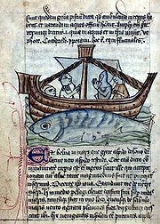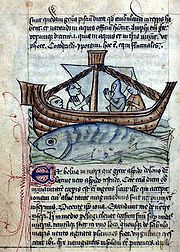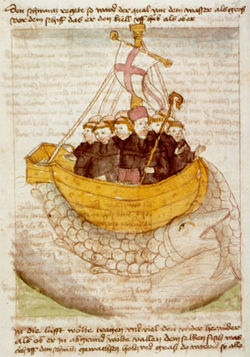
Aspidochelone
Encyclopedia

Bestiary
A bestiary, or Bestiarum vocabulum is a compendium of beasts. Bestiaries were made popular in the Middle Ages in illustrated volumes that described various animals, birds and even rocks. The natural history and illustration of each beast was usually accompanied by a moral lesson...
, the aspidochelone is a fabled sea creature, variously described as a large whale
Whale
Whale is the common name for various marine mammals of the order Cetacea. The term whale sometimes refers to all cetaceans, but more often it excludes dolphins and porpoises, which belong to suborder Odontoceti . This suborder also includes the sperm whale, killer whale, pilot whale, and beluga...
or sea turtle
Sea turtle
Sea turtles are marine reptiles that inhabit all of the world's oceans except the Arctic.-Distribution:...
, that is as large as an island
Island
An island or isle is any piece of sub-continental land that is surrounded by water. Very small islands such as emergent land features on atolls can be called islets, cays or keys. An island in a river or lake may be called an eyot , or holm...
. The name aspidochelone appears to be a compound word combining Greek
Greek language
Greek is an independent branch of the Indo-European family of languages. Native to the southern Balkans, it has the longest documented history of any Indo-European language, spanning 34 centuries of written records. Its writing system has been the Greek alphabet for the majority of its history;...
aspis (which means either "asp
Asp
Asp may refer to:Snakes:* Asp , an archaic term for a venomous snake.* Vipera aspis, a venomous viper found in Europe.* Cerastes cerastes, a venomous viper found in the Sahara desert....
" or "shield
Shield
A shield is a type of personal armor, meant to intercept attacks, either by stopping projectiles such as arrows or redirecting a hit from a sword, mace or battle axe to the side of the shield-bearer....
"), and chelone, the turtle
Turtle
Turtles are reptiles of the order Testudines , characterised by a special bony or cartilaginous shell developed from their ribs that acts as a shield...
. It rises to the surface from the depths of the sea, and entices unwitting sailors to make landfall on its huge shell. In the moralistic allegory
Allegory
Allegory is a demonstrative form of representation explaining meaning other than the words that are spoken. Allegory communicates its message by means of symbolic figures, actions or symbolic representation...
of the Physiologus and bestiary tradition, the aspidochelone represents Satan
Satan
Satan , "the opposer", is the title of various entities, both human and divine, who challenge the faith of humans in the Hebrew Bible...
, who deceives those whom he seeks to devour.
Accounts of seafarers' encounters with gigantic fish appear in various other works, including the Book of Jonah
Book of Jonah
The Book of Jonah is a book in the Hebrew Bible. It tells the story of a Hebrew prophet named Jonah ben Amittai who is sent by God to prophesy the destruction of Nineveh but tries to escape the divine mission...
and the 19th century books Pinocchio
Pinocchio
The Adventures of Pinocchio is a novel for children by Italian author Carlo Collodi, written in Florence. The first half was originally a serial between 1881 and 1883, and then later completed as a book for children in February 1883. It is about the mischievous adventures of Pinocchio , an...
and The Adventures of Baron Munchhausen
Baron Munchhausen
Karl Friedrich Hieronymus, Freiherr von Münchhausen , usually known as Baron Münchhausen in English, was a German nobleman born in Bodenwerder and a famous recounter of tall tales....
.
In the Physiologus
One version of the Latin text of the Physiologus reads:- "There is a monster in the sea which in Greek is called aspidochelone, in Latin "asp-turtle"; it is a great whale, that has what appear to be beaches on its hide, like those from the sea-shore. This creature raises its back above the waves of the sea, so that sailors believe that it is just an island, so that when they see it, it appears to them to be a sandy beach such as is common along the sea-shore. Believing it to be an island, they beach their ship alongside it, and disembarking, they plant stakes and tie up the ships. Then, in order to cook a meal after this work, they make fires on the sand as if on land. But when the monster feels the heat of these fires, it immediately submerges into the water, and pulls the ship into the depths of the sea.
Such is the fate of all who pay no heed to the Devil and his wiles, and place their hopes in him: tied to him by their works, they are submerged into the burning fire of Gehenna: for such is his guile."
In The Whale
A similar tale is told by the Old English poem The Whale, where the monster appears under the name Fastitocalon. This is apparently a variant of Aspidochelone, and the name given to the DevilDevil
The Devil is believed in many religions and cultures to be a powerful, supernatural entity that is the personification of evil and the enemy of God and humankind. The nature of the role varies greatly...
. The poem has an unknown author, and is one of three poems in the Exeter Book
Exeter Book
The Exeter Book, Exeter Cathedral Library MS 3501, also known as the Codex Exoniensis, is a tenth-century book or codex which is an anthology of Anglo-Saxon poetry. It is one of the four major Anglo-Saxon literature codices. The book was donated to the library of Exeter Cathedral by Leofric, the...
that are allegorical in nature, the other two being The Phoenix and The Panther.
- Nu ic fitte gen ymb fisca cynn
wille woðcræfte wordum cyþan
þurh modgemynd bi þam miclan hwale.
Se bið unwillum oft gemeted,
frecne ond ferðgrim, fareðlacendum,
niþþa gehwylcum; þam is noma cenned,
fyrnstreama geflotan, Fastitocalon.
- Is þæs hiw gelic hreofum stane,
swylce worie bi wædes ofre,
sondbeorgum ymbseald, særyrica mæst,
swa þæt wenaþ wægliþende
þæt hy on ealond sum eagum wliten,
ond þonne gehydað heahstefn scipu
to þam unlonde oncyrrapum . . .
-
- "This time I will with poetic art rehearse, by means of words and wit, a poem about a kind of fish, the great sea-monster which is often unwillingly met, terrible and cruel-hearted to seafarers, yea, to every man; this swimmer of the ocean-streams is known as the asp-turtle.
His appearance is like that of a rough boulder, as if there were tossing by the shore a great ocean-reedbank begirt with sand-dunes, so that seamen imagine they are gazing upon an island, and moor their high-prowed ships with cables to that false land, make fast the ocean-coursers at the sea's end, and, bold of heart, climb up."
- "This time I will with poetic art rehearse, by means of words and wit, a poem about a kind of fish, the great sea-monster which is often unwillingly met, terrible and cruel-hearted to seafarers, yea, to every man; this swimmer of the ocean-streams is known as the asp-turtle.
The moral of the story remains the same:
- Swa bið scinna þeaw,
deofla wise, þæt hi drohtende
þurh dyrne meaht duguðe beswicað,
ond on teosu tyhtaþ tilra dæda. . .
-
- "Such is the way of demons, the wont of devils: they spend their lives in outwitting men by their secret power, inciting them to the corruption of good deeds, misguiding . . ."
In The Adventures of Tom Bombadil
The Adventures of Tom Bombadil
The Adventures of Tom Bombadil is a collection of poetry written by J. R. R. Tolkien and published in 1962. The book contains 16 poems, only two of which deal with Tom Bombadil, a character who is most famous for his encounter with Frodo Baggins in The Fellowship of the Ring...
, J. R. R. Tolkien
J. R. R. Tolkien
John Ronald Reuel Tolkien, CBE was an English writer, poet, philologist, and university professor, best known as the author of the classic high fantasy works The Hobbit, The Lord of the Rings, and The Silmarillion.Tolkien was Rawlinson and Bosworth Professor of Anglo-Saxon at Pembroke College,...
made a little verse that claimed the name "Fastitocalon"
Fastitocalon (poem)
"Fastitocalon" is a poem by J. R. R. Tolkien about a beast of the same name. The setting is Middle-earth. It is included in The Adventures of Tom Bombadil, and told a similar story to that of The Whale...
from The Whale, and told a similar story:
- Look, there is Fastitocalon!
An island good to land upon,
Although 'tis rather bare.
Come, leave the sea! And let us run,
Or dance, or lie down in the sun!
See, gulls are sitting there!
Beware!
As such, Tolkien imported the traditional tale of the aspidochelone into the lore of his Middle-earth
Middle-earth
Middle-earth is the fictional setting of the majority of author J. R. R. Tolkien's fantasy writings. The Hobbit and The Lord of the Rings take place entirely in Middle-earth, as does much of The Silmarillion and Unfinished Tales....
.
Sources of the story
Pliny the ElderPliny the Elder
Gaius Plinius Secundus , better known as Pliny the Elder, was a Roman author, naturalist, and natural philosopher, as well as naval and army commander of the early Roman Empire, and personal friend of the emperor Vespasian...
's Natural History tells the story of a giant fish, which he names pristis, of immense size; he also relates the tale of sailors landing on its back, only to discover that it was not in fact land when it submerged.
The allegory of the Aspidochelone borrows from the account of whales in Saint Isidore of Seville
Isidore of Seville
Saint Isidore of Seville served as Archbishop of Seville for more than three decades and is considered, as the historian Montalembert put it in an oft-quoted phrase, "le dernier savant du monde ancien"...
's Etymologiae
Etymologiae
Etymologiae is an encyclopedia compiled by Isidore of Seville towards the end of his life. It forms a bridge between a condensed epitome of classical learning at the close of Late Antiquity and the inheritance received, in large part through Isidore's work, by the early Middle Ages...
. Isidore likens the whale to the Devil
Devil
The Devil is believed in many religions and cultures to be a powerful, supernatural entity that is the personification of evil and the enemy of God and humankind. The nature of the role varies greatly...
, and as authority cites the prophet Jonah
Jonah
Jonah is the name given in the Hebrew Bible to a prophet of the northern kingdom of Israel in about the 8th century BC, the eponymous central character in the Book of Jonah, famous for being swallowed by a fish or a whale, depending on translation...
; the Vulgate
Vulgate
The Vulgate is a late 4th-century Latin translation of the Bible. It was largely the work of St. Jerome, who was commissioned by Pope Damasus I in 382 to make a revision of the old Latin translations...
translation of the Book of Jonah
Book of Jonah
The Book of Jonah is a book in the Hebrew Bible. It tells the story of a Hebrew prophet named Jonah ben Amittai who is sent by God to prophesy the destruction of Nineveh but tries to escape the divine mission...
translates Jonah 2:2 as Exaudivit me de ventre inferni: "He (the Lord
God
God is the English name given to a singular being in theistic and deistic religions who is either the sole deity in monotheism, or a single deity in polytheism....
) heard me from the belly of Hell". On this authority, Isidore equates whales with the Devil.
Jasconius

Brendan
Saint Brendan of Clonfert or Bréanainn of Clonfert called "the Navigator", "the Voyager", or "the Bold" is one of the early Irish monastic saints. He is chiefly renowned for his legendary quest to the "Isle of the Blessed," also called St. Brendan's Island. The Voyage of St...
, where it was called Jasconius. Because of its size, Brendan and his fellow voyagers mistake it for an island and land to make camp. They celebrate Easter
Easter
Easter is the central feast in the Christian liturgical year. According to the Canonical gospels, Jesus rose from the dead on the third day after his crucifixion. His resurrection is celebrated on Easter Day or Easter Sunday...
on the sleeping giant's back, but awaken it when they light their campfire. They race to their ship, and Brendan explains that the moving island is really Jasconius, who labors unsuccessfully to put his tail in its mouth.
The same tale of a sea monster
Sea monster
Sea monsters are sea-dwelling mythical or legendary creatures, often believed to be of immense size.Marine monsters can take many forms, including sea dragons, sea serpents, or multi-armed beasts. They can be slimy or scaly and are often pictured threatening ships or spouting jets of water...
that is mistaken for an island is told in the first voyage of Sinbad the Sailor
Sinbad the Sailor
Sinbad the Sailor is a fictional sailor from Basrah, living during the Abbasid Caliphate – the hero of a story-cycle of Middle Eastern origin...
in The Book of One Thousand and One Nights
The Book of One Thousand and One Nights
One Thousand and One Nights is a collection of Middle Eastern and South Asian stories and folk tales compiled in Arabic during the Islamic Golden Age...
.
The name Jasconius is also used for the whale in the children's book The Adventures of Louey and Frank by Carolyn White. She attributes the name to having grown up with the legend of Brendan.
Milton
John MiltonJohn Milton
John Milton was an English poet, polemicist, a scholarly man of letters, and a civil servant for the Commonwealth of England under Oliver Cromwell...
also alludes to the tale of the aspidochelone in his account of the Leviathan
Leviathan
Leviathan , is a sea monster referred to in the Bible. In Demonology, Leviathan is one of the seven princes of Hell and its gatekeeper . The word has become synonymous with any large sea monster or creature...
in Paradise Lost
Paradise Lost
Paradise Lost is an epic poem in blank verse by the 17th-century English poet John Milton. It was originally published in 1667 in ten books, with a total of over ten thousand individual lines of verse...
. Milton again uses the monster as a metaphor for Satan:
- . . . or that sea-beast
Leviathan, which God of all his works
Created hugest that swim th' ocean-stream.
Him, haply slumbering on the Norway foam,
The pilot of some small night-foundered skiff,
Deeming some island, oft, as seamen tell,
With fixed anchor in his scaly rind,
Moors by his side under the lee, while night
Invests the sea, and wished morn delays.

